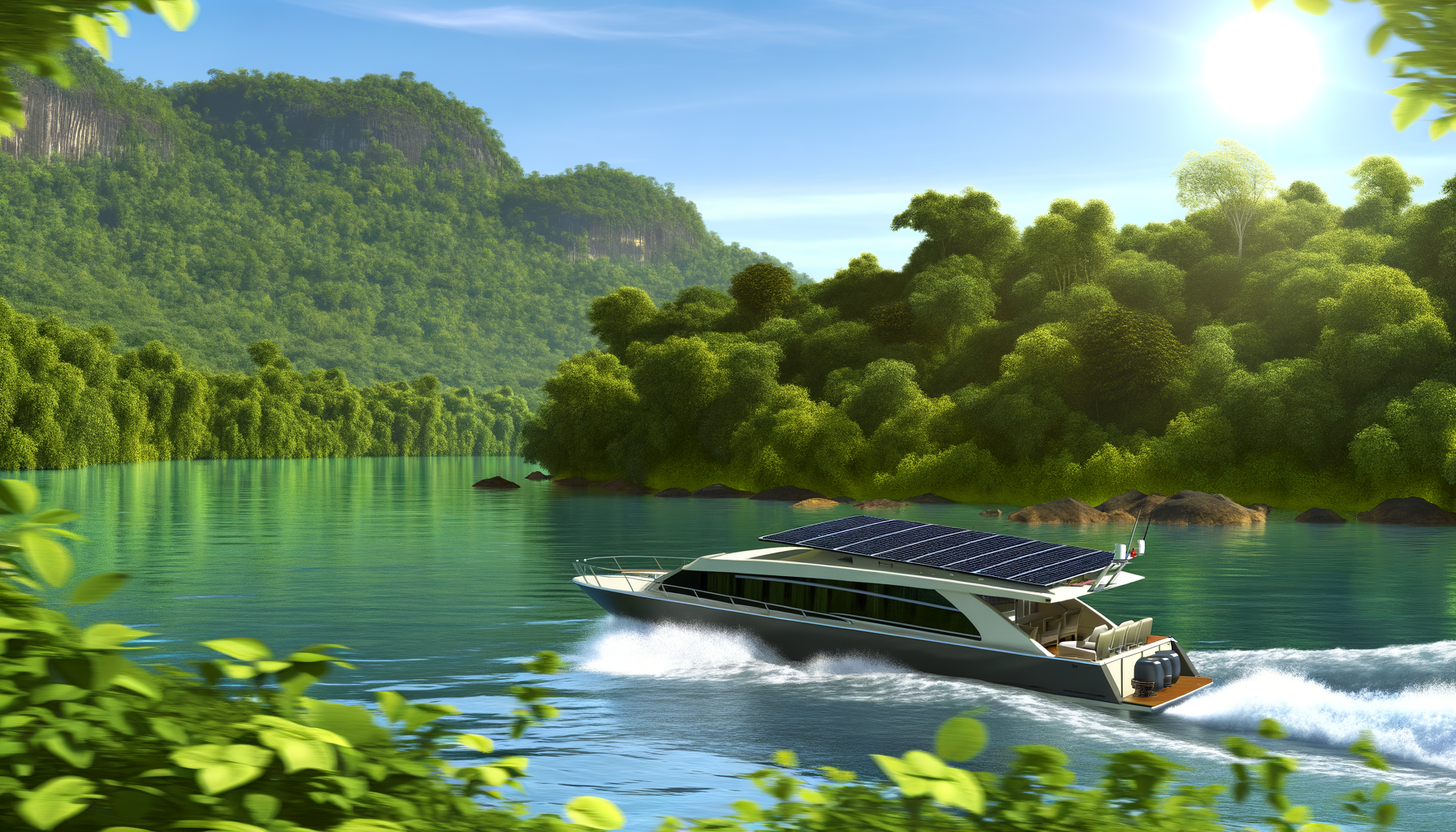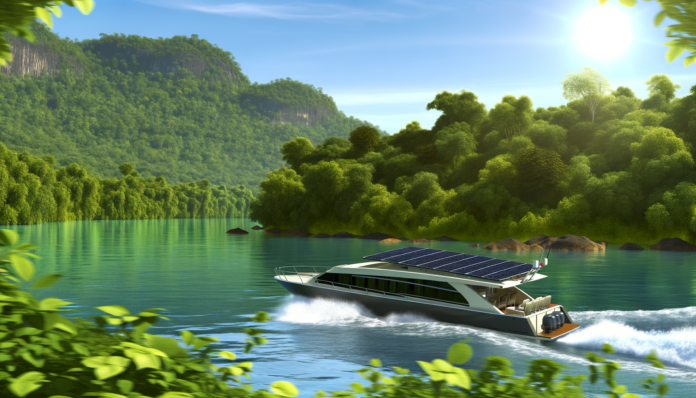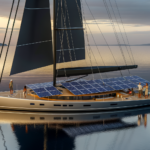
Introduction to Solar Boating
The Rise of Renewable Energy in Marine Applications
As the world increasingly seeks sustainable solutions, the marine industry is experiencing a significant shift towards renewable energy. Solar boating, in particular, has gained momentum, offering a clean, efficient, and sustainable alternative to traditional fossil fuel-powered vessels. Innovations in solar technology and increased environmental awareness have propelled the adoption of solar energy in marine applications, leading to a new era of eco-friendly boating experiences.
Benefits of Solar Power for Boaters
Solar power offers numerous advantages for boaters. Zero emissions during operation mean a reduced carbon footprint, helping to combat climate change. Boaters can enjoy the silence of electric motors, which enhances the connection with nature and minimizes disturbances to marine life. Additionally, solar power systems can lead to significant cost savings over time due to lower operating and maintenance costs compared to traditional engines. The use of solar energy also provides off-grid independence, allowing for extended trips without the need for fuel resupply.
Understanding the Basics of Solar Energy
Solar energy harnesses the power of the sun through photovoltaic cells, which convert sunlight into electricity. This electricity can be used to power boat motors and onboard electrical systems or stored in batteries for later use. Understanding the basics of solar energy, including the types of solar panels, battery storage options, and energy management, is essential for boaters looking to make the transition to solar power.
Environmental Impact and Sustainability
Adopting solar power for boating has a profound positive impact on the environment. It eliminates the risk of fuel spills, protects aquatic life, and preserves the tranquility of our water ecosystems. By reducing reliance on finite resources and minimizing emissions, solar boating aligns with the principles of sustainable resource use and responsible stewardship of our natural environment. Boaters who choose solar are actively participating in the conservation of biodiversity and the promotion of a sustainable future.
Solar Power System Components for Boats
Solar Panels: Types and Efficiency
Choosing the right solar panels is crucial for an efficient marine solar power system. The most common types are monocrystalline and polycrystalline solar panels, known for their durability and high efficiency. Monocrystalline panels, made from a single crystal structure, are more efficient and space-saving, making them ideal for boats with limited space. Polycrystalline panels, while slightly less efficient, are more cost-effective. For boats with unconventional surfaces, flexible solar panels with adhesive backing offer a versatile solution, though they typically have lower efficiency rates.
Batteries and Energy Storage Solutions
Batteries are the heart of a solar power system, storing energy for use when the sun isn’t shining. Lead-acid batteries, including AGM and Gel types, are traditional options offering reliability at a lower cost. However, lithium-ion batteries are gaining popularity due to their longer lifespan, higher energy density, and faster charging rates, albeit at a higher initial cost. The choice of battery will depend on your energy needs, budget, and the weight your boat can accommodate.
Charge Controllers and Inverters
A charge controller is essential to protect your batteries from overcharging and to regulate the voltage and current coming from the solar panels. There are two main types: PWM (Pulse Width Modulation) and MPPT (Maximum Power Point Tracking). MPPT controllers are more efficient and can maximize the energy harvested from the solar panels. An inverter converts the DC electricity stored in the batteries to AC power, which is necessary for running standard appliances and electronics on board.
System Monitoring and Maintenance Tools
Monitoring your solar power system ensures it operates at peak efficiency. Modern systems include digital displays that provide real-time data on power generation, battery charge levels, and system health. Regular maintenance is also critical; this includes cleaning the solar panels to remove salt, dirt, and debris, checking connections for corrosion, and ensuring batteries are kept at optimal charge levels. Smart maintenance tools and apps can help streamline this process, offering reminders and diagnostic information.
By understanding and selecting the appropriate components for your solar power system, you can ensure a reliable and efficient energy source for your boating adventures, all while contributing to a cleaner and more sustainable environment.
Planning Your Solar Setup
Assessing Your Energy Needs
Before diving into the world of solar boating, it’s crucial to assess your energy needs. Start by listing all electrical devices on board and their power consumption. Consider navigation systems, lighting, refrigeration, and entertainment units. Calculate the daily energy usage by multiplying the wattage of each device by the number of hours used per day. This will give you a baseline for the capacity your solar system needs to generate.
Choosing the Right Components
With your energy needs in hand, you can now focus on selecting the right components for your solar setup. The market offers a variety of solar panels, from rigid monocrystalline to flexible panels. Your choice will depend on the available space and the mounting surface on your boat. Batteries are the next critical component, acting as the energy reservoir for when the sun isn’t shining. Opt for marine-grade batteries designed for deep-cycle use. Charge controllers protect batteries from overcharging, while inverters convert the stored DC power into AC power for your appliances.
Solar Panel Placement and Sun Exposure
Maximizing sun exposure is key to an efficient solar setup. Panels should be placed where they can receive uninterrupted sunlight, considering the path of the sun and potential shading from sails or superstructures. The angle of the panels can also affect performance; some boaters opt for adjustable mounts to follow the sun’s arc. Remember, the positioning will also influence the type of panel you choose—rigid panels for fixed, unobstructed spaces, or flexible panels for curved surfaces.
Wiring and Safety Considerations
Proper wiring is essential for safety and system efficiency. Use marine-grade cables and connectors to resist corrosion and ensure secure connections. Keep cables organized and protected from the elements to prevent wear and electrical hazards. Safety should be your top priority, so install a fuse or circuit breaker between the solar panels and the charge controller, and between the batteries and the inverter. Regularly inspect your system for any signs of damage or wear.
By carefully planning your solar setup, you can enjoy the serenity of solar-powered boating with the confidence that your system is safe, efficient, and tailored to your specific needs.
Installation and Maintenance
Step-by-Step Guide to Installing Solar Panels on Your Boat
Installing solar panels on your boat is a sustainable way to generate power, but it requires careful planning and execution. Here’s a simplified guide:
- Assess the Mounting Location: Identify where on your boat the solar panels will be mounted. Consider areas with maximum sun exposure and minimal shading.
- Choose the Mounting Method: Decide whether you will use a fixed mounting system, tilting brackets, or a rail mounting system, depending on your boat’s design and your energy needs.
- Install Mounting Hardware: Securely attach the mounting hardware to your boat, ensuring it can withstand marine conditions.
- Mount the Solar Panels: Carefully place the solar panels onto the mounting hardware and secure them in place.
- Wire the Panels: Connect the solar panels to a charge controller using marine-grade wiring and connectors to prevent corrosion.
- Connect to the Battery Bank: Wire the charge controller to your boat’s battery bank, ensuring proper polarity and secure connections.
- Final Testing: Check all connections and test the system to ensure it’s functioning correctly before setting sail.
Routine Maintenance for Peak Performance
To maintain efficiency and prolong the lifespan of your solar power system:
- Clean the Panels: Regularly clean the solar panels to remove salt, dirt, and debris that can block sunlight.
- Inspect for Corrosion: Check all electrical connections for signs of corrosion and clean or replace as necessary.
- Monitor Performance: Use a system monitor to track energy production and consumption, and address any inefficiencies.
- Check Mounting Hardware: Ensure that all mounting hardware remains secure and tighten any loose components.
Troubleshooting Common Issues
If you encounter problems with your solar power system:
- Low Power Output: Check for shading on panels, dirty panels, loose connections, or damaged components.
- Battery Issues: Test the battery bank for proper charging and replace batteries if they no longer hold a charge.
- Inverter/Controller Failures: Inspect the charge controller and inverter for error messages and consult the manual for troubleshooting steps.
Upgrading Your Solar Power System
As technology advances or your energy needs change, consider upgrading:
- Add More Panels: If space allows, install additional panels to increase your energy capacity.
- Upgrade Components: Replace older components with newer, more efficient models to boost performance.
- Expand Battery Storage: Increase your battery bank to store more energy for use during low sunlight conditions.
- Install Smart Controllers: Smart controllers can optimize charging and discharging, improving overall system health.
Maximizing Efficiency on the Water
Optimizing Solar Panel Angle and Position
For solar-powered boating, the efficiency of your solar panels is paramount. To maximize energy absorption, it’s essential to consider the angle and position of your panels. The optimal angle for solar panels is one that is perpendicular to the sun’s rays. As the sun’s position changes throughout the day and with the seasons, adjustable mounting systems can be invaluable. These systems allow boaters to tilt and turn the panels to follow the sun’s path, significantly increasing energy capture. Additionally, ensure that panels are positioned to avoid shading from sails, masts, or other structures on the boat, as even partial shading can substantially reduce output.
Energy Conservation Tips While Boating
- LED Lighting: Replace all onboard lighting with LED bulbs, which consume less power and have a longer lifespan.
- Efficient Appliances: Opt for energy-efficient appliances and be mindful of usage times. Turn off devices when not in use.
- Monitor Energy Use: Regularly check energy consumption with system monitoring tools to identify areas where you can save power.
- Smart Navigation: Plan routes that take advantage of currents and wind patterns to reduce the need for motor use.
Utilizing Solar Power for Auxiliary Boat Functions
Expanding the use of solar power beyond propulsion can further enhance efficiency. Consider solar-powered water pumps, refrigeration systems, and entertainment systems. These auxiliary functions often draw significant power, and by shifting them to solar, you reduce the load on your main batteries, allowing for longer trips and reduced generator use. Additionally, solar-powered ventilation fans can help maintain a comfortable climate onboard without tapping into your primary power reserves.
Weather Considerations and Solar Energy
Weather plays a critical role in solar energy generation. Understanding weather patterns and planning accordingly can help maintain efficiency. Clear, sunny days will provide the best solar energy harvest, but even on cloudy days, solar panels can still capture energy, albeit at a reduced rate. It’s also wise to install a hybrid system that can switch to an alternative power source, such as wind turbines or a traditional generator, during prolonged periods of poor solar conditions. Always keep an eye on the weather forecast to anticipate and manage your energy reserves effectively.
In conclusion, maximizing solar efficiency on the water involves a combination of optimizing your solar panel setup, conserving energy through smart practices, expanding solar usage to auxiliary functions, and being weather-wise. By following these guidelines, boaters can enjoy the full benefits of solar power, ensuring a sustainable and enjoyable experience on the water.
Case Studies and Real-world Applications
Success Stories: Boaters Who’ve Gone Solar
The transition to solar energy in the boating world has seen a surge of success stories. Boaters are embracing solar power for its silence, sustainability, and the freedom it provides from fuel docks. One such tale is of The Silent Cruiser, a boat that once relied on gas but now glides across lakes with a bank of deep cycle batteries, significantly extending its range. Another inspiring example is a charter boat company that converted its entire fleet to electric propulsion systems powered by deep cycle batteries, thus attracting eco-conscious tourists and reducing marine ecosystem damage.
Comparative Analysis: Solar vs. Traditional Power Sources
When comparing solar to traditional power sources for boating, the benefits of solar become clear. Solar power systems offer a reduction in greenhouse gas emissions, lower operating costs, and less engine maintenance. Traditional power sources, on the other hand, contribute to air and water pollution and are subject to the volatility of fuel prices. The initial investment in solar can be higher, but the long-term savings and environmental benefits present a compelling case for solar adoption.
Innovations in Solar Boating Technology
Technological advancements are propelling solar boating forward. Innovations such as more efficient solar panels, lightweight and durable marine batteries like LifePO4, and integrated systems that combine solar with wind or hydro generation are enhancing the appeal of solar boating. Companies are also developing smart monitoring systems that allow boaters to track energy production and consumption in real-time, optimizing their energy use.
Future Trends in Solar Marine Energy
The future of solar marine energy looks bright, with trends pointing towards more integrated and efficient systems. There is a growing interest in hybrid systems that combine solar with other forms of renewable energy, such as wind or tidal power, to ensure a constant energy supply. Additionally, the development of floating solar farms could revolutionize energy generation in maritime environments. With increasing awareness of the environmental impact of traditional fuels, the boating industry is set to continue its shift towards renewable energy sources, with solar leading the way.
As the boating community increasingly adopts solar power, the ripple effects on the marine industry and the environment are profound. These case studies and trends not only showcase the viability of solar energy for boating but also highlight the potential for widespread change in how we harness energy for marine applications.
Resources and Further Reading
Educational Materials and Workshops
For boaters interested in learning more about solar energy and its applications in marine environments, a wealth of educational materials and workshops are available. Organizations such as the American Solar Energy Society (ASES) and the North American Board of Certified Energy Practitioners (NABCEP) offer workshops and certification programs for those looking to deepen their knowledge. Additionally, many local boating clubs and environmental groups host seminars and hands-on workshops focused on installing and maintaining solar systems on boats.
Online Communities and Forums for Solar Boaters
Online communities and forums are invaluable resources for boaters who have embraced solar power or are considering making the switch. Websites like SolarPanelsForum.com and CruisersForum.com have dedicated sections for discussions on solar boating, where members can share experiences, advice, and troubleshooting tips. Social media groups on platforms like Facebook and LinkedIn also serve as gathering spots for solar boating enthusiasts to connect and collaborate.
Books and Guides on Solar Boating
There are several comprehensive books and guides available for those interested in solar boating. Titles such as “Solar Power for Your Boat” by Bill Anderson and “The Complete Guide to Solar Boating” by Linda K. Alpern provide practical advice on selecting, installing, and optimizing solar power systems for marine use. These books often include case studies, technical specifications, and step-by-step installation guides.
Government Incentives and Regulations
Boaters looking to invest in solar technology should be aware of the various government incentives and regulations that can impact their decision. In the United States, the Federal Investment Tax Credit (ITC) allows boat owners to deduct a percentage of the cost of solar panel installations from their federal taxes. Additionally, some states offer rebates, tax credits, and other incentives for renewable energy projects. It’s important to research the specific regulations and incentives in your area, as they can significantly offset the initial costs of going solar. The Database of State Incentives for Renewables & Efficiency (DSIRE) is a comprehensive source for information on incentives and policies that support renewable energy in the U.S.
By utilizing these resources, boaters can confidently navigate the waters of renewable energy and make informed decisions about incorporating solar power into their marine adventures.



